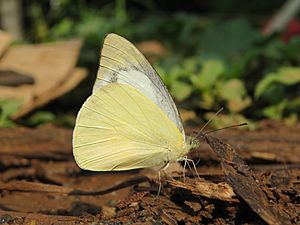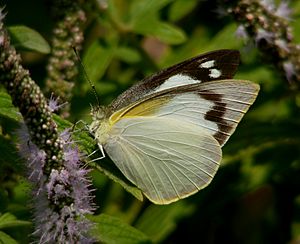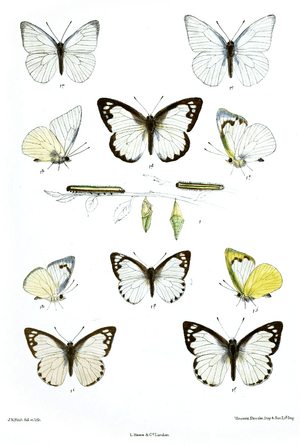Common albatross facts for kids
Quick facts for kids Common albatross |
|
|---|---|
 |
|
| male | |
 |
|
| female | |
| Scientific classification |
The Appias albina, also known as the common albatross, is a type of small butterfly. It belongs to the family of butterflies called Pieridae. You can find this butterfly in southern and southeast Asia, all the way to Australia.
Contents
Meet the Common Albatross Butterfly
This butterfly looks a lot like another butterfly called Appias paulina. However, you can tell the males apart because their front wings are more pointed. Female Common Albatross butterflies have a narrower black band on the underside of their front wings.
How Common Albatross Butterflies Change
Common Albatross butterflies can look different depending on the season. This is called dimorphism, meaning males and females look different, and their appearance can also change with the weather.
Wet-Season Look
During the wet season, male butterflies have tiny black scales sprinkled near the tips of their upper front wings. The underside of their front wings and all of their hindwings are a pale, dull yellowish color. Sometimes, they might even have a faint pink tint.
Female butterflies have two main looks during the wet season:
- First form: The black area on their upper front wing is usually straight, not rounded. The underside looks similar to the dry-season form of A. paulina females. However, the black band across the wing is narrower and has a zigzag edge.
- Second form: These females have the same markings as the first form, but their whole upper side is pale yellow. The front part of their underside is pale yellow, while the rest of the front wing and all of the hindwing are a rich, bright yellow.
The antennae (feelers) of the Common Albatross are dusky black and have many white speckles. The underside of the male's body (thorax) is white, never yellow.
Dry-Season Look
In the dry season, both males and females look similar to their wet-season forms, but with some differences.
- Males: The black scales on their upper wings are much fewer, or sometimes completely gone. The yellowish color on their undersides is much paler.
- Females: The black markings on their upper wings are smaller. On the underside, the black band across the front wing is even narrower and can look a bit faded.
These butterflies usually have a wingspan (the distance from one wingtip to the other) of about 60 to 74 millimeters.
You can find the Common Albatross in places like Sikkim (up to about 1,200 meters high), Bengal, and parts of western and southern India. They also live in northeastern India, Burma, and the Malay Peninsula.
Life Cycle of the Common Albatross
Like all butterflies, the Common Albatross goes through a fascinating life cycle, starting as a tiny egg.
The Larva (Caterpillar)
The caterpillar of the Common Albatross is light green. It has a yellow-white stripe along its side, from the second body segment to the twelfth. This stripe gets a bit wider at the twelfth segment. Its head is round, shiny, and yellow, covered with small, black, cone-shaped bumps that have tiny hairs. The caterpillar's body is rough, with six rows of similar small, black, bumpy spots across each segment.
The Pupa (Chrysalis)
The chrysalis (pupa) is a dirty whitish color, sometimes with a pinkish shade on some segments. It has a long, flattened, and slightly curved head-part that ends in a point. The edges of this head-part are slightly jagged. The second body segment has a small tooth-like bump, and the back of the body has a strong ridge. The thorax (middle part of the body) also has a strong ridge. The side teeth on segments 6, 7, and 8 are all the same size and pointed. The head-part, the bumps on segment 2, and the teeth on segments 6 and 7 (sometimes) are black.
What Do They Eat?
Common Albatross caterpillars like to eat the leaves of certain plants. These include Drypetes oblongifolia, Drypetes roxburghii, and Drypetes venusta.
Gallery






